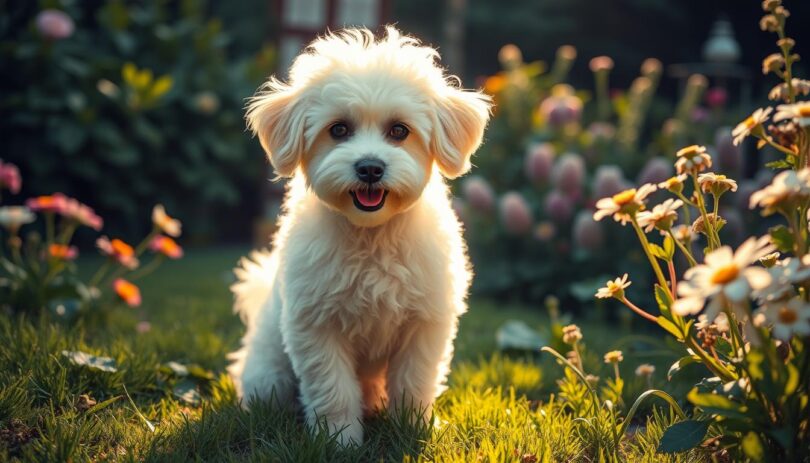Picture a companion whose presence feels like sunshine on a rainy day—playful, loyal, and endlessly affectionate. For many, this vision becomes reality with the bichon poodle cross, a charming hybrid celebrated for its joyful spirit and adaptability. Whether you’re a busy professional or a parent seeking a gentle family pet, this breed’s magnetic personality often feels tailor-made for modern life.
Known as the Poochon, this designer mix combines the intelligence of a Toy Poodle with the cheerful demeanor of a Bichon Frise. Its hypoallergenic, curly coat sheds minimally, making it ideal for allergy sufferers. Beyond practicality, these compact companions thrive on human connection, often forming strong bonds with everyone in the household.
Standing under a foot tall, their petite frame and teddy-bear appearance captivate hearts effortlessly. Urban dwellers appreciate their adaptability to apartment living, while active families love their enthusiasm for playtime. Despite their small stature, they carry a big personality—curious, social, and eager to please.
Training this hybrid proves rewarding thanks to their quick learning ability and food-motivated nature. Positive reinforcement techniques yield fast results, whether teaching basic commands or fun tricks. Their loving temperament shines brightest when included in daily routines, whether curling up during movie nights or joining outdoor adventures.
For those seeking a low-maintenance yet deeply affectionate pet, the Poochon delivers. Its blend of practicality and charm continues to win over households nationwide, proving great things truly come in small packages.
Introduction to the Bichon Poodle Cross
In the world of designer pets, few mixes balance charm and practicality like this curly-coated companion. Developed by blending the Bichon Frise and Miniature Poodle, this hybrid brings together low-shedding coats and adaptable personalities. Its rise in popularity stems from a winning combination of intelligence and affection, making it a standout choice for diverse households.
Overview of This Charming Companion
Originating as a crossbreed in the late 20th century, these pets inherit the Poodle’s hypoallergenic fur and the Bichon’s cheerful disposition. Most weigh 10-15 pounds, with plush coats ranging from snowy white to cream or apricot. Their rounded eyes and compact build create an approachable, teddy-bear-like appearance.
Why Families Embrace This Mix
Households adore their adaptable nature—equally content with apartment lounging or park adventures. Their eager-to-please attitude simplifies training, especially when using reward-based methods. Social by nature, they thrive when included in daily activities, whether assisting with chores or snuggling during downtime.
Parents appreciate their gentle interactions with children, while allergy sufferers value minimal shedding. Regular brushing maintains their soft curls, and moderate exercise keeps them mentally stimulated. This blend of low-maintenance care and loyal companionship explains their growing presence in American homes.
History and Origins of the Bichon Poodle Cross
Designer hybrids often reflect cultural shifts in pet ownership, and this curly-coated companion emerged during the 1990s surge in intentional crossbreeding. Australian breeders sought to merge the Toy Poodle’s sharp intellect with the Bichon Frise’s warm-hearted nature, creating a low-shedding companion for urban households.
From Designer Breed to Beloved Companion
Both parent breeds carried royal European legacies. Poodles served as water retrievers in Germany, while Bichons charmed French nobility. Their modern popularity in Australia made them ideal candidates for hybridization. Breeders prioritized health and temperament, selecting dogs with robust genetics and friendly dispositions.
Early Poochons quickly gained attention for their adaptability. However, their rising demand led to irresponsible breeding practices. Many ended up in shelters when owners underestimated their grooming needs. Rescue organizations now play a vital role in rehoming these hybrids.
Today’s enthusiasts appreciate their layered heritage. The mix’s journey from novelty to household staple mirrors evolving attitudes toward hybrid vigor. Thoughtful breeding practices continue refining their traits, ensuring they remain healthy companions for diverse families.
A Closer Look at the dog breed bichon poodle cross
Imagine a living teddy bear with eyes that spark curiosity—this hybrid captures hearts through its distinctive look. Standing 9-15 inches tall, its compact frame balances sturdiness with delicate proportions. The rounded skull and button nose create an irresistibly soft expression.
Typical Appearance Details
Most weigh 10-15 pounds, making them ideal lap companions. Their signature coat varies from tight curls to loose waves, inheriting the Poodle’s hypoallergenic texture. Weekly brushing prevents tangles, while professional trims every 6-8 weeks maintain shape.
Expressive round eyes—often dark brown—peer out beneath fluffy bangs. Ears typically fold downward, blending the Bichon’s feathered edges with the Poodle’s softer droop. These features give each individual a one-of-a-kind charm.
Unique Blend of Bichon Frise and Poodle Heritage
Some showcase the Bichon’s pure white plushness, while others display apricot hues from their Poodle lineage. Lighter shades often deepen around the ears and paws as they mature. This color diversity means no two look exactly alike.
The mix’s adaptability shines in its physique. Athletic enough for brisk walks yet content with indoor play, it suits various lifestyles. Owners appreciate how training sessions leverage both breeds’ intelligence, making trick mastery a breeze with consistent rewards.
Physical Characteristics and Appearance
Compact yet sturdy, this hybrid’s physical traits combine practicality with undeniable charm. Its proportions reflect a careful balance between the parent breeds, creating a distinct silhouette that’s both functional and endearing.
Size, Build, and Coat Colors
Measuring 9-15 inches tall and weighing 6-18 pounds, their frame supports an active lifestyle while remaining apartment-friendly. The body structure leans toward square proportions, with a deep chest and muscular legs inherited from the miniature poodle lineage.
Coat textures vary from tight spirals to cloud-like waves, often in white, cream, or apricot shades. Some develop subtle caramel highlights around the ears and paws as they mature. This hypoallergenic fur requires weekly brushing to prevent mats but sheds minimally.
Facial Features and Body Structure
Expressive dark eyes peer out beneath a fluffy forehead, framed by folded ears that blend Bichon Frise softness with poodle elegance. The rounded muzzle and black nose create a perpetually youthful expression.
Veterinarians note potential structural issues common to small dog breeds, including patellar luxation and dental crowding. Responsible breeders screen parent dogs to minimize these risks. Regular checkups help catch early signs of joint disease or eye problems.
Temperament and Personality Traits
At the heart of every great companion lies a personality that turns houses into homes. This mix thrives on connection, blending warmth with sharp instincts to create bonds that endure. Their adaptable nature makes them equally suited for quiet evenings or lively family gatherings.
Affection, Loyalty, and Playful Nature
These pets greet life with tail-wagging enthusiasm. They form deep attachments to household members, often following favorite people from room to room. Gentle interactions and patient guidance help them build trust with children and seniors alike.
Playfulness remains a hallmark trait. Interactive games like fetch or puzzle toys keep their minds engaged. While they enjoy bursts of activity, they’re equally content lounging beside you after a 30-minute walk. This balance makes them ideal for both active households and calmer environments.
Intelligence and Ease of Training
Quick learners excel with reward-based methods. Short, varied sessions work best—think 10-minute drills with treats or praise. Many master basic commands in weeks, while advanced tricks keep their curiosity sharp.
Mental stimulation prevents boredom-related behaviors. Rotate toys weekly and introduce new challenges like scent games. Early socialization with other pets and diverse environments fosters confidence, ensuring they grow into well-adjusted adults ready for any adventure.
Grooming, Coat Care, and Maintenance
Maintaining a healthy, tangle-free coat requires consistent care tailored to this hybrid’s unique needs. Their soft curls demand attention to stay clean and mat-free, while routine upkeep supports overall wellness.
Daily Grooming Routines to Prevent Matting
Start with a slicker brush to gently detangle the undercoat. Focus on areas prone to knots—behind the ears, under the legs, and around the collar. Finish with a metal comb to smooth the top layer.
Owners should brush every 2-3 days, increasing frequency during seasonal shedding. Leave-in conditioner spray helps manage frizz between sessions. Always check for debris after outdoor activities.
Professional Maintenance and Trim Guidelines
Schedule grooming appointments every 4-6 weeks for shaping trims. Professionals use curved shears to maintain the signature teddy bear look while preventing skin irritation. Ask for rounded paw pads and trimmed facial hair for clearer vision.
Monthly ear cleaning prevents infections. Use vet-approved solution and cotton balls—never cotton swabs. Trim nails every 3-4 weeks to avoid overgrowth that affects posture.
Consistent care reduces risks of hot spots and dermatitis. Introduce puppies to brushing early using treats and praise. Keep sessions under 5 minutes initially to build positive associations.
Training Techniques and Socialization
Building good habits starts early with this intelligent hybrid. Their sharp minds thrive on structured guidance paired with playful engagement. Owners who combine consistency with creativity often see remarkable results in behavior and bonding.
Early Obedience Training Methods
Short 5-10 minute sessions work best for maintaining focus. Clicker training paired with high-value treats reinforces desired actions like “sit” or “stay.” Always end on a positive note to keep experiences rewarding.
Complex commands become achievable through incremental steps. Teaching “roll over” might start with “down,” then adding gentle guidance. Puzzle toys challenge their problem-solving skills between formal lessons.
Socializing for a Joyful Home Environment
Expose puppies to diverse sounds, surfaces, and people before 16 weeks. Controlled playdates teach appropriate interactions with other dogs. Car rides and patio visits build confidence in new environments.
Address excessive barking by redirecting attention to toys or commands. Consistent routines prevent anxiety-related issues. Many owners find group classes invaluable for reinforcing social skills alongside basic obedience.
Regular exercise through walks or fetch sessions channels energy positively. Mental stimulation remains equally important—rotate training games weekly to sustain interest. A well-rounded approach fosters adaptability that lasts a lifetime.
Exercise, Nutrition, and Vital Energy
A thriving companion needs balanced energy from activity and nutrition. For these lively hybrids, daily movement and mindful eating habits form the foundation of lifelong wellness. Let’s explore how to keep them vibrant through tailored routines.
Daily Activity and Feeding Guidelines for Optimal Health
Thirty minutes of exercise daily maintains their zest. Split this into two walks and interactive play sessions. Puzzle toys or fetch games engage their sharp minds while burning energy.
Measured meals prevent weight gain—a common issue in small breeds. Feed high-quality kibble formulated for active companions twice daily. Consult your vet to determine portions based on age and activity level.
Leaving these social pets alone for extended periods risks anxiety-related behaviors. Pair alone time with chew toys or calming music. For detailed care strategies, explore our complete guide to their care.
Regular weigh-ins help spot early signs of health concerns. Combine lean proteins, fiber-rich veggies, and controlled treats. This approach supports joint health and digestion while fueling their playful nature.
By balancing movement and nutrition, owners nurture resilient companions ready for life’s adventures. Consistent routines build vitality that shines through every wag and leap.
Common Health Issues and Veterinary Care
Understanding potential health challenges helps owners safeguard their pet’s well-being long-term. While generally healthy, these hybrids may inherit conditions from their parent breeds. Regular veterinary partnerships and early detection strategies make all the difference.
Preventative Measures and Regular Checkups
Annual exams catch issues before symptoms arise. Bloodwork and joint assessments screen for endocrine disorders or patellar luxation. Reputable breeders provide health clearances for both parents, reducing genetic risks.
Maintain a health log tracking vaccinations, appetite changes, or unusual behaviors. Schedule dental cleanings every 12-18 months to prevent periodontal disease. Monthly heartworm prevention and flea control are non-negotiable in most climates.
Recognizing and Managing Common Conditions
Allergies often manifest as itchy skin or ear infections. Hypoallergenic diets or medicated shampoos usually resolve these. Progressive retinal atrophy requires lifestyle adjustments like avoiding furniture rearrangement.
Watch for limping—a sign of luxating kneecaps. Weight management and joint supplements help manage this condition. For detailed care strategies, consult veterinarians familiar with small breeds.
Owners should research both Bichon Frise and Poodle lineage health histories. Early intervention transforms manageable issues into lifelong solutions rather than crises. Knowledge truly becomes your pet’s best ally.
Finding the Right Poochon: Adoption or Reputable Breeder
Choosing between adoption and purchasing requires thoughtful evaluation of your household’s needs. Rescue organizations often have adult mixes needing homes, while breeders provide puppies with documented health histories. Both paths offer unique rewards when approached responsibly.
Rescue Options Versus Purchasing from a Breeder
Adopting through shelters or breed-specific rescues saves lives and typically costs less. Many rehomed pets come house-trained and socialized. However, availability varies, and allergy sufferers may prefer breeders who verify coat traits through parent testing.
Reputable breeders prioritize genetic health screenings and early socialization. They openly share veterinary records and introduce buyers to parent dogs. Avoid sellers who can’t provide proof of health clearances or pressure quick decisions.
Key Questions to Ask When Choosing a Breeder
Always inquire about:
- Health certifications for hips, eyes, and heart conditions
- Socialization methods used during the first 12 weeks
- Return policies if allergies or incompatibilities arise
Ethical breeders encourage visits and maintain lifelong support. For those exploring Poodle hybrids, verify their experience with Bichon Frise crosses specifically. Transparency about lineage reduces risks of inherited conditions.
Whether adopting or purchasing, prioritize sources that value temperament and long-term welfare. Thorough research ensures your new companion thrives in their forever home.
Final Reflections on Your Bichon Poodle Cross Journey
Welcoming a new companion into your home requires thoughtful consideration of both joys and responsibilities. The Poochon’s hypoallergenic coat and cheerful temperament make it a standout choice for many households. Its blend of intelligence and affection bridges the gap between playful energy and calm companionship.
Regular grooming sessions and daily exercise remain essential for maintaining their well-being. Training thrives on consistency, while socialization ensures they adapt smoothly to diverse environments. Potential owners should prioritize health screenings and responsible breeders to minimize genetic risks.
This mix’s adaptability shines in apartments or active families, provided they’re not left alone for extended periods. Those drawn to cream or apricot coats must commit to brushing routines. Remember—every pet’s needs vary based on lineage and individual personality.
By researching breeders thoroughly and understanding care requirements, you create a foundation for lasting happiness. The right match brings laughter, loyalty, and countless shared moments. Approach pet ownership with open eyes and a prepared heart—your perfect companion awaits.
FAQ
Are Bichon Poodle mixes hypoallergenic?
Their low-shedding coats make them suitable for mild allergy sufferers, though no breed is truly hypoallergenic. Regular grooming reduces dander and allergens in your home.
How often do they need professional grooming?
Schedule trims every 6-8 weeks to maintain their curly coat. Daily brushing prevents mats, especially behind ears and under legs where tangles form.
Do they adapt well to apartment living?
Yes, their small size (10-15 lbs) and moderate energy suit smaller spaces. Daily walks and interactive play sessions help manage their vitality indoors.










Leave a Comment